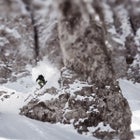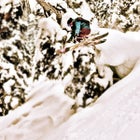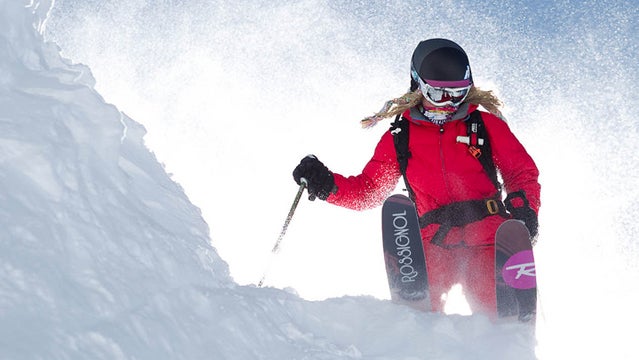In the beginning, big-mountain skier Lynsey Dyer didn’t realize she could get paid to ski powder. She was an alpine racer, having won a downhill junior Olympic title at age 16. But on a whim and at the encouragement of her cousin AJ Cargill, a pioneering female freeskier, Dyer entered an extreme skiing competition in 2002 while a student at Montana State University. She won it and then nabbed every big-mountain event she ever entered, including the Freeski World Tour overall title in 2005.
The Snow Report
The latest snow, ski, and winter sports stories from ���ϳԹ���. Lynsey Dyer.
Lynsey Dyer. Lynsey Dyer.
Lynsey Dyer.Since then, Jackson Hole, Wyoming-based Dyer, 30, has become one of the world’s most accomplished female skiers. She once held the record for biggest air for a woman and was anointed Powder magazine’s Female Skier of the Year in 2010. She’s been featured in over 25 magazines (snagging the covers of five), 14 films, and scored the lead segment of Warren Miller’s Like There’s No Tomorrow. It was the first time a female sequence opened a Warren Miller film.
But Dyer’s contributions transcend her many feats made on mountains. In 2008, she launched SheJumps, a non-profit that aims to encourage women’s participation in outdoor sports and empower them through their engagement with the mountains. She’s an activist, artist, and photographer. In 2010, she spent a month in India working with children who’d been rescued from child labor, slave, and sex trades. In May 2011, a photo she shot of BASE jumpers in Yosemite, California, appeared in National Geographic. In January 2013, she hosted a TED talk in Jackson Hole about “compassion, forgiveness, and connection.”
Most recently, she’s been working on a two-year film project called Pretty Faces, a movie about women and their dedication to the mountains, which will debut in fall 2013. Pretty Faces will feature Ingrid Backstrom, Angel Collinson, and Jess McMillan, among many other talented skiers. Dyer also encourages any female skier out there to film herself this winter and submit the footage for consideration.
Here, Dyer talks about her upcoming film, the unique challenges female skiers face, and her dream ski day.
How did you become a pro skier?
I never meant to become a pro skier. I didn’t even know it was possible to get paid to ski without racing. I just loved the freedom of powder.
What’s your dream ski day?
I’d start the day touring from a heli-accessed hut. I’d ski perfect, stable spines and fluffy pillows with all of my best friends and the man of my dreams. The rest of the day would be in the heli and end with a sauna, steam shower, and a dance party.
Can you talk about your film Pretty Faces? What’s the idea behind it?
Oftentimes us girls in athletics are portrayed in media not for our talent but for our looks, and I wanted to offer a platform and a voice to celebrate all the best parts of being a girl in the mountains. Namely, our grace, intuition, and our giggles, as well as our drive to push limits while supporting our sisters living up to their greatness as well.
The film and Web episodes will focus not only on our athletic achievements as skiers, snowboarders, or mountain bikers, but as participants in the outdoor sports community as well. The film will also focus on camaraderie, adventure, art, tools for facing fears, and other aspects of mountain living that make a healthy, balanced lifestyle worth living.
Where did the idea come from? When will it come out?
I had dedicated my winters to filming for years, putting my body on the line and oftentimes wouldn’t see worthy footage ever show up in the films. That, or we’d only see quick blips from girls spread out in films, easily lost. I knew if it was happening to me it must be happening to others. I figured if I pooled all of our collective highlights together we might have more of an impact as a whole. That way we could spotlight some of women’s achievements, offer them a voice, and share with the outside world what this lifestyle looks like from a different perspective most hadn’t seen in the action sports realm.
However, my greatest motivation is to offer healthy role models to girls other than what mainstream media pumps out. We want to prove to little girls everywhere that the mountain lifestyle is an option for them, and that everyone from a waitress to a mom to a doctor can find her place on a mountain. I want inspire people through the films. Here’s the .
Who is in the film?
My goal is to work collectively with as many individuals, filmers, production companies, and sponsors to show just how many of us there are. I want to tell the collective community’s story of women who love mountains and what it takes to keep mountains a priority. I’m looking for anyone who loves skiing, both young and old, nurses and guides, teachers and moms who share the common joy of being in the mountains, what they have taught us, and the challenges we fight to be in them.
You, Rachel Burks, and a few women are making ladies-only ski films. What do you attribute this trend to?
I think there are a few of us who have been knocking on the door for a long time and are finally willing to take matters into our own hands. We want to see more females getting after it and girls want their story to be told. I think it’s time.
What are the challenges women face in getting involved in outdoor sports like climbing, skiing, and mountain biking?
I didn’t have many female role models in mainstream media when I was growing up. Jane Goodall is all I can think of. To me, society told me to really make it, one had to either be a sexy singer or a sexy actress. I couldn’t relate to either of those, so I looked to men as role models for a long time. Then I realized I had abandoned some really powerful parts of myself as a female—that boys are also programmed to set aside—like being willing to feel fear or tapping into intuition to make good decisions in the mountains.
What challenges have you personally experienced being a professional female skier?
Sometimes I get opportunities for the wrong reasons. There have been a few “let’s talk about sponsorship or film segment over dinner” offers. It’s hard to find a potential partner who sees real value in me other than for simply modeling gear or as a date. Luckily, the sponsors I have now see value in all that I have to offer—as an athlete, an artist, and someone passionate about creating more opportunities for kids and women to feel welcome in the mountains.
What motivates you?
The biggest challenge and greatest form of motivation I’ve found is when people don’t think I am capable of something. It makes me appreciate duality and controversy. The whole, “Hold my beer and watch this” mentality is a pretty fun way to make myself step up.
Why did you launch SheJumps?
We created SheJumps in 2008 to build a supportive community to encourage more girls and women to challenge themselves outside. We started it for a few reasons: To make a team out of an individual sport where girls could feel a sense of belonging to a mountain community and create a platform to use the metaphor of the mountains to challenge oneself to her highest potential.
You’re helping pave the way for young, up-and-coming female skiers. Who helped pave the way for you?
My mom and cousin AJ Cargill were always pushing boundaries and still are, but this movement has been coming for a long time … like centuries. Even men are starting to appreciate their inner “girl” and it’s serving our planet as a whole. It’s not easy to break old molds but if we have the courage to tap into our grace, intuition, and genuine love for what we are doing, that raw desire to make a mark will manifest itself in a beautiful way. It’s never been a better time to be a girl.
Can you talk about the differences in skiing with a group of women versus skiing with a group of men?
I have to admit, I’ve been afraid of groups of women. We learn early about mean girls, so I’ve always been wary. That’s part of what we are trying to combat with SheJumps. Girls can be mean, especially when they are young, but I believe if they had better role models, they could learn that the worst thing they can do for themselves is to be mean to other girls. We are easily threatened by each other. However, I think we’re starting to see ourselves as a force that can move mountains if we work side-by-side to get real sheroes in the spotlight. Those athletes pushing boundaries, moms keeping our families intact against all odds, conservationists fighting for the trees, and do-gooders empowering the less-fortunate, will be what we aspire to.
Are things different now for female skiers now, than from when you first got into the business? If so, how?
Yes, definitely. There is more room than ever for female skiers. Something shifted this year and people are excited and open to women skiers more than before. It’s like we hit a tipping point.
Who have been/are your mentors in the mountains?
Shroder Baker, Rob Kingwill, Kina Pickett, Jimmy Chin, Rob Deslauriers, Kent McBride, AJ Cargill, Ian Mackintosh.
What do you consider to be the biggest accomplishment of your career?
My greatest accomplishment thus far has been recognizing my own capacity to follow my intuition and finally seeing the value in it versus looking outside for answers or affirmation. SheJumps is the thing I’m most proud of because it keeps me accountable to the person I most want to be, for my team, and the kids and women we serve.
I think others might find my biggest accomplishment to be asked to give a TED talk, being Powder magazine’s skier of the year in 2010 or the two-page spread that was published in National Geographic that I shot as the photographer. Those have been dreams and goals for a long time that I never imagined would be on my path.
What are your goals for your career? What’s next?
I want to inspire people and kids on a large scale to reach their highest potential through having fun outside and sharing a sense of belonging to nature. I want to share this experience through film, television, design, art, and speaking to schools, and workshops. We have this amazing metaphor for learning life skills and pushing personal limits in the mountains and all I want to do is share the gifts they’ve offered me.


